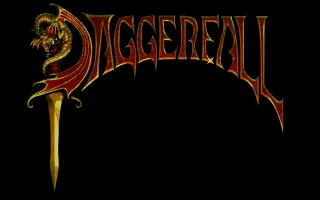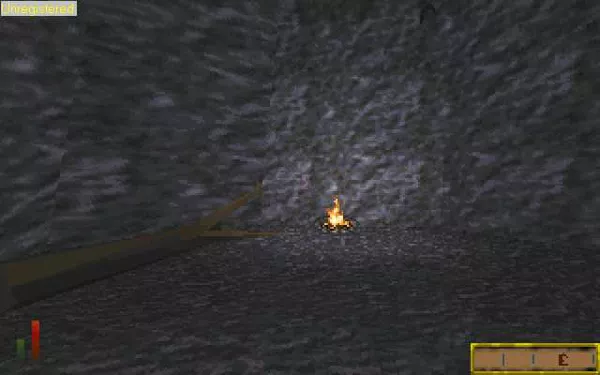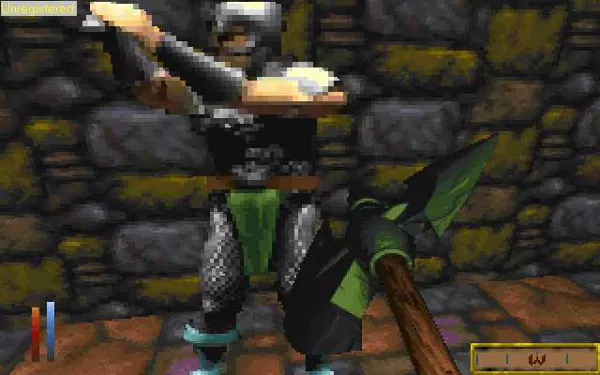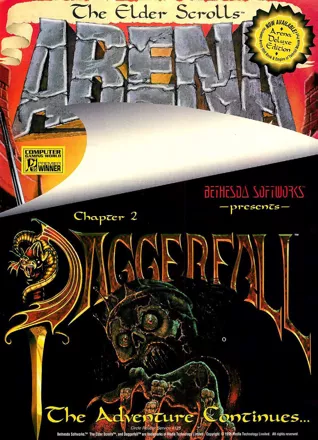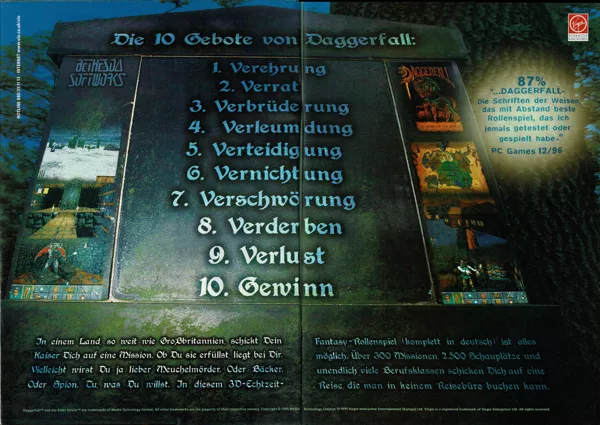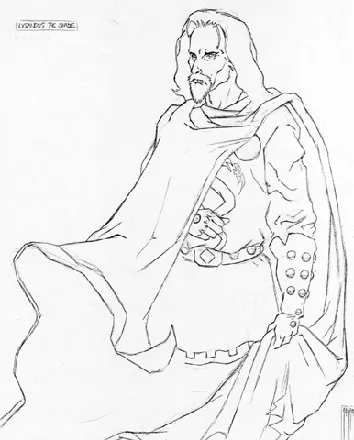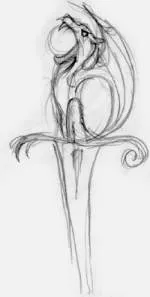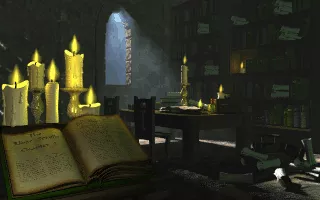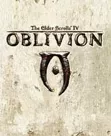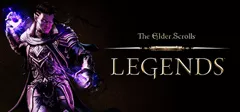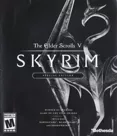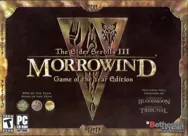The Elder Scrolls: Chapter II - Daggerfall
Description official descriptions
Daggerfall is a sequel to The Elder Scrolls: Arena; it is set in the same medieval fantasy world Tamriel - more specifically, in the homeland of the Breton race, known as High Rock, and the province Hammerfell, home of the Redguards. The game's title is derived from the name of High Rock's capital city.
The main protagonist travels to Daggerfall at the request of the emperor Uriel Septim. His mission involves freeing the ghost of the late King Lysandus. Apparently, a letter concerning the king and sent by the emperor to the court in Daggerfall contains information about a dangerous ancient power. It is now up to the hero to retrieve the letter, reveal the dark secret that has been preserved in the king's family, and eventually discover the key to the resurrection of an iron golem who wields immense power.
Like its predecessor, Daggerfall is an open-ended role-playing game, in which the main quest is but a small fraction of the various missions and assignments the player is able to undertake. The game is notable for breaking records concerning the size of its world (though much of it has been generated randomly). Interaction with hundreds of thousands of non-playable characters is possible. The player is free to join one of the many political and social organizations of Tamriel, as well as pursue a personal quest for power. The player is able to buy houses, ships, and horses, as well as become a werewolf, a vampire, or a wereboar.
Combat in Daggerfall is action-based: the player uses the mouse to determine the direction and the power of sword swings and shots from a ranged weapon. Character growth is handled somewhat similarly to that of Quest for Glory games: the more the player performs an action, the better the protagonist becomes at it. For example, swinging the sword will eventually increase the player character's attack power and skill with that weapon, etc. This extends to non-combat activities such as jumping, bartering, speaking foreign languages, etc. Leveling up occurs when several main and secondary skills have been raised sufficiently. During character generation the player is given the option to create and name his or her custom classes by combining attributes and skills.
Groups +
- 3D Engine: XnGine
- Animals: Cats
- Elder Scrolls series
- Fantasy creatures: Elves
- Fantasy creatures: Orcs
- Game feature: In-game screenshot capture
- Gameplay feature: Alchemy
- Gameplay feature: Character development - Repetition
- Gameplay feature: Day / night cycle
- Gameplay feature: Journal
- Gameplay feature: Paper doll inventory
- Gameplay feature: Pickpocketing
- Gameplay feature: Seasonal change
- Games with randomly generated environments
- Live action cut-scenes
- Nudity
- Protagonist: Female (option)
Screenshots
Promos
Videos
Add Trailer or Gameplay Video +1 point
See any errors or missing info for this game?
You can submit a correction, contribute trivia, add to a game group, add a related site or alternate title.
Credits (DOS version)
65 People · View all
| Project Leader | |
| Programming | |
| Additional Programming | |
| Design | |
| Additional Design | |
| Art | |
| Box Cover Illustration | |
| Additional Art | |
| [ full credits ] | |
Reviews
Critics
Average score: 81% (based on 26 ratings)
Players
Average score: 4.0 out of 5 (based on 110 ratings with 8 reviews)
Where wereboars visit endless cities on sleepless nights
The Good
Daggerfall follows the design philosophy pioneered by its predecessor, dropping you into a gigantic world in which you can role-play to your heart's content. In this installment they refined and expanded the ideas of the original, which resulted in a deeper, more immersive game that many fans still consider the apex of the series.
Daggerfall prides itself on having one of the largest worlds ever created for a game. Indeed, its vastness is absolutely mind-boggling. At first sight the world appears smaller than the one of Arena, containing only two provinces instead of the entire Tamriel. However, such calculation is misleading: each province has many more points of interest, so the overall impression is that of an even bigger and certainly busier environment. There are more than a dozen of fiefdoms in the province, each with dozens of towns, dungeons, and other specified locations. Words can't even begin to describe how huge the whole thing is.
The role-playing system that comes with this world is much deeper and more flexible than the fairly basic rules of Arena. In the beginning you are treated to an elaborate character creation, which includes the awesome possibility of customizing your chartacter's class. You can combine various attributes and skills together and create whatever you feel your protagonist should be like. I spent a long time trying to make the perfect character, and even restarted the game after having completed the first dungeon.
The game introduces what later become the staple of the series: the skill system. Rather than leveling up in the old-fashioned way, by gathering experience points (like in Arena), you become stronger by repeatedly executing the same action. This system might not be to everyone's taste, but it is certainly more absorbing than the one of its predecessor, and very addictive. Seeing how every action has a direct impact on your character's growth is exhilarating; which Elder Scrolls player hasn't made his protagonist merrily hop through vast landscape and slash the air with a short sword, patiently waiting for the magic words "your skill has increased" to appear?
Much of the world in Daggerfall is randomized, just like in Arena; however, the game conceals this randomness better. Part of this comes courtesy of the graphics, which are noticeably more varied and do a more convincing job at creating an illusion of a living, breathing world. This is particularly evident in dungeon design; the starting location of Daggerfall grabbed me right away with its ominous atmosphere, while in Arena I had to first get out of the imperial prison in order to become really interested in the game. The dungeons are very complex and hard to navigate, but the emotional reward you receive for completing them only adds to the game's addictiveness. The immersion is complimented by excellent sound effects and the optional, but highly recommended mouse-look exploration mode.
Tamriel of Arena was a mishmash of fantasy elements put together with little coherence. In Daggerfall, this world is a much more detailed, individualized environment, with its own background and lore, racial, political, and social dynamics, etc. The leap in quality is instantly noticeable and constitutes perhaps the main reason for the game's improvement over its predecessor. Well-written books are scattered all over the world, providing enjoyable reading that surpasses the randomized in-game dialogue. Rummaging through dungeon loot or public libraries in search of the third volume of a pseudo-historical pulp novel with sexual overtones is just one of those many little goals that can engross so much in this game.
The higher level of detail in the world is more than just a cosmetic choice; plenty of gameplay mechanics have been added to the core formula to enhance and deepen the experience. There are many more types of quests, and you can now join various guilds and ascend in their ranks. You earn reputation which is affected by your actions. You can become involved in the politics of High Rock and Hammerfell, siding with various organizations. Time passes by, just like in Arena, but this time you also get timed quests, and your reputation depends on how often you visit a particular guild and accept quests from it. Add to this the ability of making your own magic spells, the possibility to contract a disease and become a vampire, a werewolf, or a wereboar (each with its own set of rules, advantages, and disadvantages), and you'll begin to see how varied and involving the game can become despite its generally repetitive nature.
On top of that, the main quest of Daggerfall is by far more interesting than the generic "gather eight pieces of something to defeat the bad guy" we've seen in Arena. Not only is the main story ripe with conspiracies and hidden agendas, it is also branching: you can choose between several different characters and organizations to support, each with its own goals, as well as influence the game's ending and the fate of Tamriel through your decisions.
The Bad
In many ways Daggerfall was ahead of its time, and it is clear that technology is to be blamed for most of the flaws found in this outstanding virtual world. It was obviously impossible to hand-craft such a massive environment with the 3D capabilities of the time. Daggerfall hides its randomness better than Arena, and has much more personality; but after playing for a while, cracks begin to show in the magnificent edifice that is its world.
There is no true continuous world in the game in the same sense as in, for example, Ultima VI. The world outdoors has no real locations; it consists of randomly generated, identically-looking terrain that stretches without end. Theoretically you can physically explore it and discover towns and dungeons on your own; in practice, this is a very boring activity, since there are no landmarks at all in this world, not even roads or anything else to distinguish one place from another. A convenient fast travel opinion is provided, which unfortunately takes away from the joy of exploration.
Towns and dungeons are perfectly functional and acceptable for whatever gameplay they offer; but visually, they are repetitive and lack coherence. There are huge towns in this world, but they lack planning, clearly displaying random elements. Buildings are positioned without much logic, and it is hard to get attached to a particular town when you know there are hundreds of others that look more or less the same. In a strange way, it contributes to the game's impartiality: you choose "your" town, "your" guild, "your" quest etc. out of many similar ones and individualize it with your choice. But lack of original features in towns and other locations eventually make the playing process tiresome and nearly depressing.
The game's dungeons are twisted monstrosities that make those of Phantasy Star II look like linear pathways. The 3D map is, frankly, almost completely useless and confuses more than it helps. I loved the dungeon crawling in the game, but I was nearly physically exhausted after having spent several hours in a devilish maze before almost accidentally stumbling on the life-saving exit symbol.
The game's main quest can be easily broken, so if you intend to follow it, don't deviate from its prescribed path. Having to fulfill level requirements for triggering the next stage of the quest can get annoying. Even though the story is interesting, don't expect interaction with fascinating characters or anything of the sort. The NPCs in the game are random, and as such have absolutely no personality, unless your fantasy complements their lack of such by deliberately singling them out, treating them in particular ways, etc. It is the same as with towns: the quantity is overwhelming, but there is hardly any quality to speak of.
The Bottom Line
No amount of problems can change the fact that Daggerfall is an immersive, deeply addictive game, astounding in its vision, flexibility of gameplay, and sheer size. This game won't satisfy those who play RPGs only to encounter interesting people and read cleverly written dialogues; it appeals much more to the type of player that finds joy in complete, head-spinning freedom. For what it's worth, Daggerfall is a huge, awe-inspiring virtual playground that surpasses in scope everything that was done before or after it.
DOS · by Unicorn Lynx (181780) · 2011
A massive, ambitious masterpiece that just missed 'perfect'.
The Good
Daggerfall is a massive, open game; anyone who has played it will tell you that. The land you can explore is twice the size of the UK, the dungeons are as of yet unrivaled in size in any other game, and the towns are pleasantly life-sized.
The premise of the game is that you can make your own adventure. In this, it succeeds; Daggerfall is the epitome of non-linear. This is obvious from the character generation, where you have the option to make your own class-- the class-making system is an amazingly fun part of the game which includes the options to add special advantages and disadvantages such as phobias, resistances, and specialties.
The non-linearity isn't just in the character generation process, however; it lasts throughout the game. There are a number of guilds to join-- assortments of temples and knightly orders that vary from country to country add to the normal selection of Thieves, Warriors, and Mages (and Assassins!) guilds-- each of which offer their own 'quests'. These quests are the building blocks of the game. They vary greatly, although about 45% are dungeon-hack quests.
The world around you feels alive, to a certain extent. The NPCs feel far from lifelike-- more on that in the downsides section-- but the intricacies and details of the world of Tamriel that the game is set in are a great help to the level of immersion. There are simulated weather effects, very rare for when the game was made, including snow and rain. When winter comes, the buildings, ground and trees are covered with snow.
The music is very good for the time, especially if you set up your sound the right way. Sound effects are decent; not impressive technicly speaking, but they work really well in-game. Monsters each have their own distinct sound, and when you hear something new in a dungeon, like a mummy's low, mourning cry or the horrific scream of a Lich, you're likely to be scared out of your wits. And if you are an arachaphobic, like me...
Shudder.
As for the game mechanics, they are generally excellent. The game does not use the typical 'experience points equals a level' system; instead, the skills you use are the ones that increase. This system is so much better then the normal one, it's really hard to explain. The spell system is interesting; you can buy default spells, or make new ones in the Mages Guild. This is not nearly as refined as in Morrowind, but it is still fun and interesting.
I could go on for a long time about how you can collect ingredients to make potions, enchant your own items, collect various pieces of the different armor the game offers, get a horse and/or cart, buy your own house, buy your own ship, etc, but that would make this review far too long. Instead, I'll move on the 'main quest'.
The main quest sneaks up on the player in the form of an innocent letter regarding the topics of the quest the Emperor sent you to this part of Tamriel for, which are explained to you in the introductory movie. From here, the quest branches into many directions. It's always more complex then you think, and in the end when you've figured it all out and solved both halves of the main quest, you'll have made your way through a spellbinding story of deception, intrigue, and betrayal. And the game doesn't end there-- you are welcome to continue exploring. Your adventure goes on for as long as you want.
The Bad
Bugs! That is the main downside you'll hear about Daggerfall. Bugs. The game is pretty buggy even with the latest 2.13 patch, and even when you've learned to avoid things that bug the game. It is bearable, however.
Another bad thing is the NPCs. NPCs you see wandering around towns are not just cookie-cutter-NPCs-- they are generated on the spot, and they change when you enter the town again! The other NPCs you will meet that are important to quests or plots are static, but feel unlifelike. They are represented by a single pixilated picture that is occasionally animated, and they don't fight. Things that fight, you can't interact with. This is a big failure of the game and, in my opinion, its primary shortcoming.
Other issues include how many quests are hell to solve, because you have to hack through a dungeon that, as you'll swear up and down when you finally get out, spanned all of Tamriel underground. The game isn't balanced; it's painfully easy to use various exploits, and powergamers will soon tire of how pathetically easy everything becomes after 10th level.
There are so many little issues that pester the game. A totally bugged logbook is one of them; you can record about 5 things people said in conversations before it resets itself. Another is the Automap; it's a great idea, having a 3d Automap you can view from different angles and navigate easily, but it just doesn't work like it should, and it's barely any help in the nightmarishly maze-like dungeons you will oft encounter.
The Bottom Line
Daggerfall remains one of the best RPGs of all time. I personally think that only Morrowind, the very recent sequel, is a superior game (and of course it is, given the time difference! Here's to hoping TES 4 will be better then Daggerfall and Morrowind both). It is truly a masterpiece, a classic; it should live on forever in the memories of gamers. It is flawed, of course, and perhaps had the developers not been so extremely ambitious in planning it, it would have turned out a much better, more solid game. But its massiveness is what makes it so captivating, what sets it apart from all the rest. If you like RPGs, this is a must-have game.
DOS · by ShadowShrike (277) · 2004
The Good
Probably the most open ended game I've ever played! You are free to go anywhere, do anything to anyone...at least that's how it feels. Though having certain technical problems, it is a very atmospheric game...when you are crawling in the dungeons with the lights off, you actually get scared. Also, the possibility of owning property (houses, ships and a wonderful wagon) was unique in those days and very rare, these days.
Wonderful game.
The Bad
It was full of bugs...
The Bottom Line
Superb...
DOS · by Alexandre Reis (3) · 2005
Discussion
| Subject | By | Date |
|---|---|---|
| Do these (DOSBox-ed) as a free bonus count as a Windows release? | Cavalary (11445) | Dec 25, 2015 |
| Daggerfall Soundtrack Remake | Pieces of 8-bit | Dec 3, 2015 |
| It's FREEEEEEEEEEEEEEEEEE | Foxhack (32100) | Jul 18, 2009 |
Trivia
CompUSA release
In order to get Daggerfall carried in CompUSA stores, a special edition of the game was requested. The CompUSA version has 16 extra quests added to the game. A patch was later released that added these extra quests to the standard version of the game.
Freeware release
The game was offered as freeware on July 9, 2009 in celebration of fifteen years of Elder Scrolls.
Graphics
Daggerfall's creature art is an interesting mix of hand-drawn work and rendered material. All of the creatures, in fact, originally had 6 frames to every animation, but this had to be chopped down considerably to compress the size of the game which was already monstrously large for the time it was released.
The only remaining trace of these original detailed animations is in a "bestiary" video describing several of the creatures of Daggerfall.
Awards
- Computer Gaming World
- November 1996 (15th anniversary issue) – #8 Top Vaporware Title in Computer Game History
- May 1997 (Issue #154) – Role-Playing Game of the Year
Information also contributed by PolloDiablo.
Analytics
Upgrade to MobyPro to view research rankings!
Related Sites +
-
Daggerfall at Wikipedia
Information about The Elder Scrolls: Daggerfall at Wikipedia -
Doug's Daggerfall Page
A Fansite dedicated to Daggerfall. -
TES: The Essential Site
A site for Daggerfall, featuring one of the largest surviving conclaves of fans. -
The Tamriel Compendium
The Tamriel Compendium has lots of info about Daggerfall (and a few files), including a bestiary with creature sounds. -
The UESP
The Unofficial Elder Scrolls Pages is one of the oldest sites about the Elder Scrolls series. It has huge amounts of information about Daggerfall.
Identifiers +
Contribute
Are you familiar with this game? Help document and preserve this entry in video game history! If your contribution is approved, you will earn points and be credited as a contributor.
Contributors to this Entry
Game added by Omniscia.
Windows Apps added by Plok. Windows added by Rik Hideto.
Additional contributors: Brian Hirt, ShadowShrike, Alaka, formercontrib, Yearman, Patrick Bregger.
Game added January 23, 2000. Last modified April 2, 2024.


